mobile View, to the German Version tap the flag


- Republic of Azerbaijan
- own name: Azerbajdshan Respublikasy
• Flag
• Historical Flags
• Meaning/Origin of the Flag
• Coat of Arms
• Historical Coats of Arms
• Meaning/Origin of the Coat of Arms
• Aircraft Roundel
• Map
• Numbers and Facts
• History
• Origin of the Country's Name
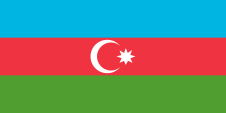
National flag,
ratio = 1:2,
Source, by:
Flags of the World






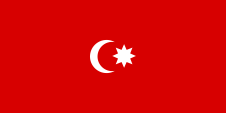
1918,
National flag,
Source, by: Wikipedia (DE)



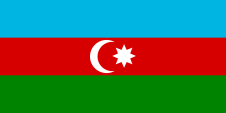
1918–1920,
National flag,
Source, by: Flags of the World



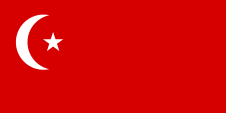
1920–1921,
Flag of the Azerbaijan Soviet Socialist Republic,
ratio = 1:2
Source, by: World Statesmen



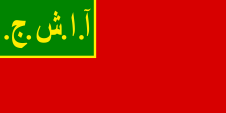
1921–1922,
Flag of the Azerbaijan Soviet Socialist Republic,
ratio = 1:2
Source, by: World Statesmen



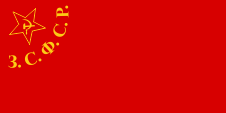
1922–1936,
Flag of the Transcaucasian Socialist Soviet Republic,
ratio = 1:2,
Source, by: Flags of the World



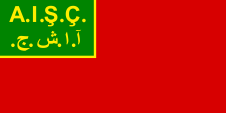
1922–1925,
Flag of the Azerbaijan Soviet Socialist Republic,
ratio = 1:2
Source, by: World Statesmen




1925–1927,
Flag of the Azerbaijan Soviet Socialist Republic,
ratio = 1:2
Source, by: World Statesmen




1927–1931,
Flag of the Azerbaijan Soviet Socialist Republic,
ratio = 1:2
Source, by: World Statesmen



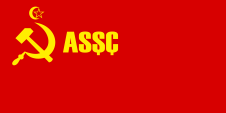
1931–1937,
Flag of the Azerbaijan Soviet Socialist Republic,
ratio = 1:2
Source, by: World Statesmen



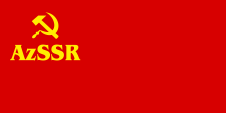
1937–1940,
Flag of the Azerbaijan Soviet Socialist Republic,
ratio = 1:2
Source, by: World Statesmen



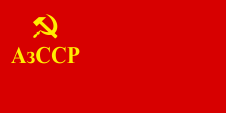
1940–1952,
Flag of the Azerbaijan Soviet Socialist Republic,
ratio = 1:2
Source, by: World Statesmen



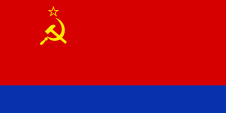
1952–1991,
Flag of the Azerbaijan Soviet Socialist Republic,
ratio = 1:2,
Source, by: Flaggen und Wappen



look also:
Flag history of the soviet republics of the USSR

The flag of Azerbaijan was created in the beginning of the 20th century by the poet Ali Bey Hussein Zade, adoped by the Musavat party, and undertook as state flag for the independent Azerbaijan on 25th of August in 1918. When the Red Army occupied the country in 1920, a red flag with Turkish symbols in the upper corner was first introduced for the Azerbaijani Soviet Socialist Republic, which was formed on 28th of April in 1920. The Azerbaijanis are a Turkic people. It was thus possible to combine the nationalism that became free after Russian rule with the communist symbolism (the color red). After just one year, the crescent moon and star were removed and an Islamic green upper corner with golden initials of the Soviet republic written in Arabic letters was placed. In 1922, the Transcaucasian Soviet Socialist Republic (as part of the Soviet Union) was established, including Azerbaijan, which had its own flag. It was not dissimilar to the flag of Soviet Russia between 1918 and 1924. The star with hammer and sickle in it was placed in the leech of the flag, and the initials of the Federation in a semicircle around it. After the end of the federation (1936), Azerbaijan joined the USSR (Soviet Union). During the years as part of the Transcaucasian Soviet Socialist Republic (1922-1936) Azerbaijan kept its own flag. The Arabic initials in the upper corner have been supplemented by Latin letters. In 1925 the green upper corner was removed and the communist symbols hammer and sickle were added and the crescent moon and star also appeared in an Islamic-communist combination. From 1931 the initials of the Soviet republic appeared only in large Latin letters, crescent moon and star were removed in 1937 and from 1940 Cyrillic letters were used. In 1952 was adoped a new flag. It was a draft of the painter K. M. A. Kjazimzade, and was single colour red with a narrow, horizontal blue stripe on the underneath border, which stood for the Caspian Sea. Nearby the flagpole the flag showed in the middle of the red stripe in gold the symbols of communism, hammer, sickle and five-jagged star. The flag from the 25th of August 1918 was reintroduced on 5th of February in 1991. It shows three horizontal stripes in blue, red and green with a white half-moon and a white eight-jagged star in the red middle stripe. The eight jags of the white star stand for the Azeri (Azerbaijani), Turks, Tatars, three Kazakh tribes, Uzbeks and for the Turkomans. For the interpretation of the colors there are two theories: 1. The pale blue symbolizes the heaven, red stands for the freedom, and green for the fruitfulness of the land. 2. The pale blue is the color of the Azeri, and expresses therewith whose affiliation to the group of the Turk nation, red stands for the cultural development, and green for the fruitfulness of the land. The color green, the half-moon and the star are moreover islamic symbols.
Source: Flaggen und Wappen der Welt,
Flaggen Enzyklopädie,
Alle Flaggen alle Staaten,
World Statesmen


since 1991,
Coat of arms of Azerbaijan,
Source: !Original: BetacommandBotVector: Zscout370, Public domain, via Wikimedia Commons

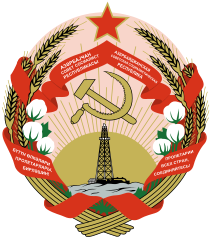
1978–1991,
Coat of arms of Azerbaijan,
Source:
TheSign 1998, Public domain, via Wikimedia Commons,
via Wikipedia (EN)

1930–1936,
Coat of arms of the Transcaucasian Socialist Soviet Republic,
Source:
Jam123, CC0, via Wikimedia Commons

The today's coat of arms of Azerbaijan was adoped in 1991. It is a round one, and shows three concentric circles in green, red and blue. Above that, over all, a large eight-jagged white star with red flames in the center. That should symbolize the Zarathustrism respectively the oil fields of Baku. Below the scutcheon a wreath from oak twigs and grain ears.
Source: Flaggen und Wappen der Welt

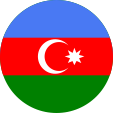
Aircraft Roundel,
Source, by: Wikipedia (EN)

Location:
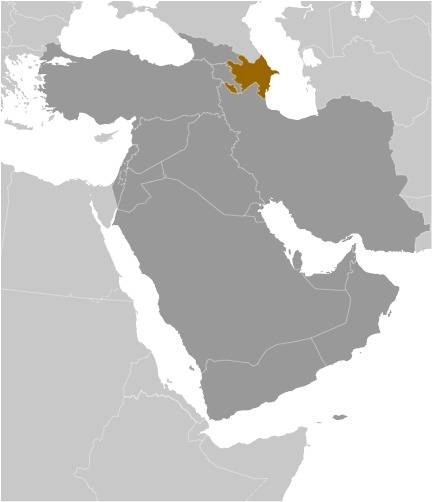
Source: CIA World Factbook
Map of the country:
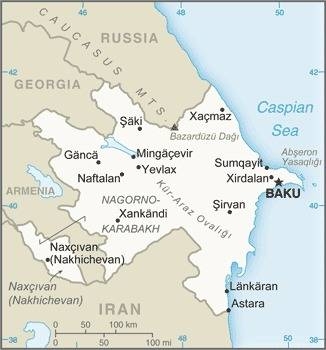
Source: CIA World Factbook

Area: 33.436 square miles
Inhabitants: 10.357.000 (2019), thereof 92% Azerbaijani (Azeri), 2% Lezgins, 1,3% Armenians (Haik), 1,3% Russians
Religions: 87,7% Muslim (Shia), 9,2% Muslim (Sunna), 3% Christian
Density of Population: 310 inh./sq.mi.
Capital: Baku (Baki), 2.181.800 inh. (2014)
official Language: Azerbaijani
other Languages: Russian, Georgian, Avar, Armenian
Currency: 1 Azerbaijan-Manat (AZN) = 100 Gepik
Time Zone: GMT + 4 h
Source: Wikipedia (D),
CIA World Factbook

7th cent. · to the Persian empire
654 · Arabian conquest
11th cent. · Turkish conquest
13th cent. · Mongolian conquest
14th cent. · conquest by Persia
1806–1813 · conquest by Russia, Governments of Baku and Yelisavetpol
1917 · communist revolt attempt
28th of May 1918 · establishment of the State of Azerbaijan on the area of the former Russian Government of Baku, the former Russian Government of Yelisavetpol comes to Armenia
1920 · Soviet-Russian conquest of Azerbaijan and Armenia, the former Government of Yelisavetpol (and in this way Nagorno-Karabakh and Nakhitshevan) becomes separated from Armenia and annexed to Azerbaijan, Azerbaijan becomes a soviet republic within the der USSR (Soviet Union)
1922 · Georgia, Armenia and Azerbaijan become under force fusioned to the Trans-Caucasisian Federation
1936 · dissolution of the Trans-Caucasisian Federation, once more joining of Azerbaijan to the USSR
1988 · the territorial council (soviet) of Nagorno-Karabakh demands the annexation to Armenia, because of that there take place pogroms against Armenians in Nagorno-Karabakh
1989–1994 · ethnical civil war in and for Nagorno-Karabakh, invasion of Soviet-Russian troops, it comes into being war between Armenia, Azerbaijan and Soviet-Russian troops and troops of Nagorno-Karabakh, Azerbaijan declares the autonomy-status of Nagorno-Karabakh for terminated
1990 · Nagorno-Karabakh declares itself for a republic
23th of August 1991 · Armenia declares its Unabhängigkeit from the Soviet Union
30th of August 1991 · Azerbaijan declares its Unabhängigkeit from the Soviet Union
8th of December 1991 · ultimate disintegration of the remaining Soviet Union
1993 · troops of Armenia and Nagorno-Karabakh conquer large parts of Azerbaijan, Nagorno-Karabakh (now directly bordering to Armenia) becomes economical associated to Armenia but maintains the status of a republic
1994 · general cease fire
October/November 2020 · renewed fighting for the Nagorno-Karabakh Republic, the Armenian and Nagorno-Karabakh troops retreat fighting from the attacks of the Azerbaijani troops (supported by Turkey and Islamist militias), and within weeks, large areas in the south of the Nagorno-Karabakh Republic will be lost to Azerbaijan before the ceasefire, Russia provides a peacekeeping force
19th of September in 2023 · Azerbaijani troops invade Nagorno-Karabakh, Armenian and Nagorno-Karabakh troops ask for ceasefire within one day, Azerbaijan takes control of the whole territory and initiates the annexation of land and people, mass exodus of Nagorno-Karabakh Armenians to Armenia and in refugee camps, the Nagorno-Karabakh Republic effectively ceases to exist, Azerbaijan officially ends the country on 1st of January in 2024
Source: Atlas zur Geschichte,
Wikipedia (D)

The name "Azerbaijan" is composed of the two Caucasian or Old Iranian words "azer" (fire) and "baykan" (Guardian). It means translated "guardian of the fire" and refers to the Zoroastrian temples (Worshipers of fire).
Source: Handbuch der geographischen Namen


![]()















































